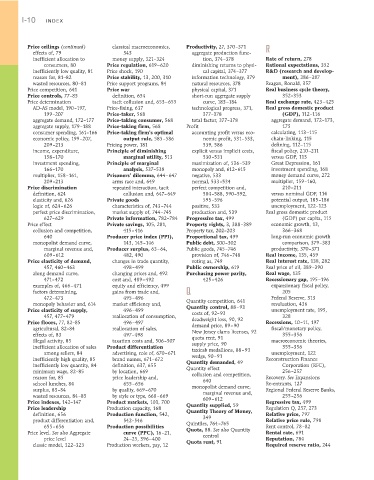Page 920 - Krugmans Economics for AP Text Book_Neat
P. 920
I-10 INDEX
Price ceilings (continued) classical macroeconomics, Productivity, 27, 370–371 R
effects of, 79 343 aggregate production func-
inefficient allocation to money supply, 321–324 tion, 374–378 Rate of return, 278
consumers, 80 Price regulation, 619–620 diminishing returns to physi- Rational expectations, 352
inefficiently low quality, 81 Price shock, 190 cal capital, 374–377 R&D (research and develop-
reason for, 81–82 Price stability, 13, 200, 310 information technology, 379 ment), 386–387
wasted resources, 80–81 Price support programs, 84 natural resources, 378 Reagan, Ronald, 357
Price competition, 641 Price war physical capital, 371 Real business cycle theory,
Price controls, 77–85 definition, 654 short-run aggregate supply 352–353
Price determination tacit collusion and, 653–655 curve, 183–184 Real exchange rate, 423–425
AD-AS model, 190–197, Price-fixing, 637 technological progress, 371, Real gross domestic product
199–207 Price-taker, 568 377–378 (GDP), 112–116
aggregate demand, 172–177 Price-taking consumer, 568 total factor, 377–378 aggregate demand, 172–173,
aggregate supply, 179–188 Price-taking firm, 568 Profit 175
consumer spending, 161–166 Price-taking firm’s optimal accounting profit versus eco- calculating, 113–115
economic policy, 199–207, output rule, 585–586 nomic profit, 531–533, chain-linking, 115
209–213 Pricing power, 181 539, 586 defining, 112–115
income, expenditure, Principle of diminishing explicit versus implicit costs, fiscal policy, 210–211
158–170 marginal utility, 513 530–531 versus GDP, 113
investment spending, Principle of marginal maximization of, 536–539 Great Depression, 161
166–170 analysis, 537–538 monopoly and, 612–615 investment spending, 168
multiplier, 158–161, Prisoners’ dilemma, 644–647 negative, 533 money demand curve, 272
209–213 arms race and, 649 normal, 533–534 multiplier, 159–160,
Price discrimination repeated interaction, tacit perfect competition and, 210–211
definition, 624 collusion and, 647–649 584–588, 590–592, versus nominal GDP, 114
elasticity and, 626 Private goods 595–596 potential output, 185–186
logic of, 624–626 characteristics of, 743–744 positive, 533 unemployment, 122–123
perfect price discrimination, market supply of, 744–745 production and, 539 Real gross domestic product
627–629 Private information, 782–784 Progressive tax, 499 (GDP) per capita, 115
Price effect Private savings, 105, 281, Property rights, 3, 388–389 economic growth, 13,
collusion and competition, 415–416 Property tax, 202–203 366–368
640 Producer price index (PPI), Proportional tax, 499 long-run economic growth
monopolist demand curve, 143, 145–146 Public debt, 300–302 comparison, 379–383
marginal revenue and, Producer surplus, 63–64, Public goods, 745–746 productivity, 370–371
609–612 482, 490 provision of, 746–748 Real income, 135, 459
Price elasticity of demand, changes in trade quantity, voting as, 749 Real interest rate, 138, 282
457, 460–463 498–499 Public ownership, 619 Real price of oil, 389–390
along demand curve, changing prices and, 492 Purchasing power parity, Real wage, 135
471–472 cost and, 489–492 425–426 Recessionary gap, 195–196
examples of, 466–471 equity and efficiency, 499 expansionary fiscal policy,
factors determining, gains from trade and, Q 205
472–473 495–496 Federal Reserve, 313
monopoly behavior and, 614 market efficiency and, Quantity competition, 641 revaluation, 436
Price elasticity of supply, 496–499 Quantity control, 88–93 unemployment rate, 195,
costs of, 92–93
457, 477–479 reallocation of consumption, 328
Price floors, 77, 82–85 496–497 deadweight loss, 90, 92 Recessions, 10–11, 197
demand price, 89–90
agricultural, 82–84 reallocation of sales, New Jersey clams licenses, 92 fiscal/monetary policy,
effects of, 83 497–498 quota rent, 91 355–356
illegal activity, 85 taxation costs and, 506–507 supply price, 90 macroeconomic theories,
inefficient allocation of sales Product differentiation taxicab medallions, 88–93 355–356
among sellers, 84 advertising, role of, 670–671 unemployment, 122
wedge, 90–91
inefficiently high quality, 85 brand names, 671–672 Quantity demanded, 49 Reconstruction Finance
inefficiently low quantity, 84 definition, 637, 655 Quantity effect Corporation (RFC),
minimum wage, 82–85 by location, 669 collusion and competition, 256–257
reason for, 85 price leadership and, 640 Recovery. See Expansions
school lunches, 84 655–656 monopolist demand curve, Re-entrants, 127
surplus, 83–84 by quality, 669–670 marginal revenue and, Regional Federal Reserve Banks,
wasted resources, 84–85 by style or type, 668–669 255–256
609–612
Price indexes, 142–147 Product markets, 103, 700 Quantity supplied, 59 Regressive tax, 499
Price leadership Production capacity, 168 Quantity Theory of Money, Regulation Q, 257, 273
definition, 656 Production function, 542, 349 Relative price, 797
product differentiation and, 542–546 Quintiles, 764–765 Relative price rule, 798
655–656 Production possibilities Rent control, 78–82
Price level. See also Aggregate curve (PPC), 16–21, Quota, 88. See also Quantity Rental rate, 691
control
price level 24–25, 396–400 Reputation, 784
classic model, 322–323 Production workers, pay, 12 Quota rent, 91 Required reserve ratio, 244

